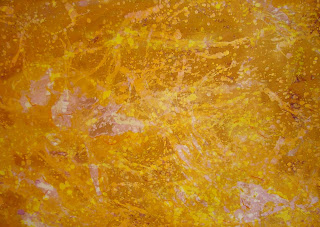This is a necklace I made from the polymer clay beads in a previous photo. In addition to the polymer clay beads I made, I added Swarovski bicone beads, Czech rondelle beads, sterling bead caps. There is no clasp - this is 26" long, and fits over the head. $60.00.
Thursday, August 22, 2013
Friday, August 9, 2013
Batik/Weaving Process
The first step: splatter melted wax over a sheet of Arches watercolor paper, and cover that with a wash of acrylic paint.
The second step: Melting the splattered wax with the hair dryer I use for art purposes.
Here's a photo of the melted wax mixing with the paint. Interestingly enough, some orange appeared at this point.
The next step: Adding more wax dribbles, then adding a wash of olive green. After I added the green, I wiped off the excess color with a soft cotton cloth.
Here, I've added more wax, then added a wash of red.
Now, I've wiped off the excess red, and I've added more splatters of wax.
I added a wash of blue-violet here.
I've wiped off the excess paint, and I'm ready to iron out the wax.
To iron out the wax, I placed the sheet of Arches onto a soft layer of cotton cloth, placed another sheet of Arches onto the first sheet of paper that is covered with color and wax. I then covered all with another clean cotton cloth, and began ironing out the wax. The colors lightly transferred to the top sheet, which you see on the right. The ironing process took about 1/2 hour.
I drew lines, spaced 1/2 inch apart, onto the back, and began cutting with an X-Acto knife. I decided to not use a straight-edge rule, but went for a more natural cut. There is a margin of three inches on the top and sides, and 3 1/2 inches along the bottom.
I cut strips out of the first sheet - there is a 1 /12" strip on the bottom row, here. I also cut three strips that are 1" wide, three that are 3/4" wide, and the rest are 1/2" wide. Again, I measured them before cutting but cut "freehand" as opposed to using a straight-edge.
This photo shows the weaving as it progresses.
This is me, with my really serious face that I get when I work on my stuff.
I'm measuring the strips to make sure that they're even on both sides.
The last two strips are more difficult to put in, since the weaving is tight at this point. They don't just slide in, like the others did. So I bring the strip straight up, then stab it straight down, gently pulling it to get it to go through.
Another view of working in the last strip. I'm working at my kitchen table. I did all of this in the kitchen, but covered the table with plastic while I was doing the pouring and painting.
The last loop/strip.
I'm pushing the strip here.
Another view of the last couple of inches.
Now the weaving is done, and I need to batten down the edges that are creeping up.
Inspecting the woven piece to see where I still need to get those edges to lie flat.
Trimming the back - and I have left-over strips set aside for another free-form weave.
Here you can see my numbers on the back of the strips. I number them after drawing the guide/cutting lines because I like to keep them in the order in which they were cut. It's just a "thing" with me.
The back is now trimmed and the edges of the strips are glued down tightly.
Here's the first photo of the finished weaving - it's a little darker looking than it is "in person".
These are my mat choices - the lighter one will have the artwork mounted on it. The darker one will be the cut mat. The finished size will be 36" x 28", and I'll use a gold metal frame on it.
Subscribe to:
Comments (Atom)
















+strand.+Now+you+see+my+work+station,+aka+the+kitchen+table....JPG)














,+and+I'll+use+a+gold+metal+frame..JPG)